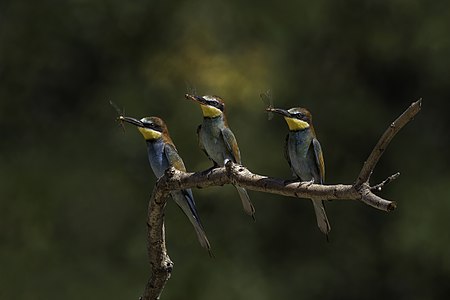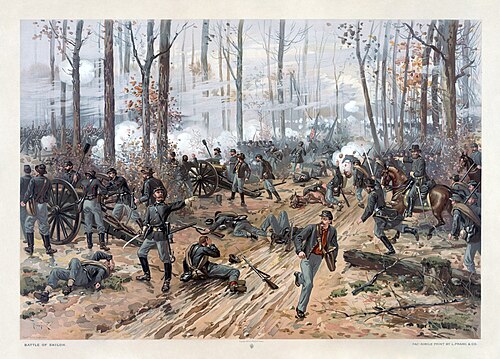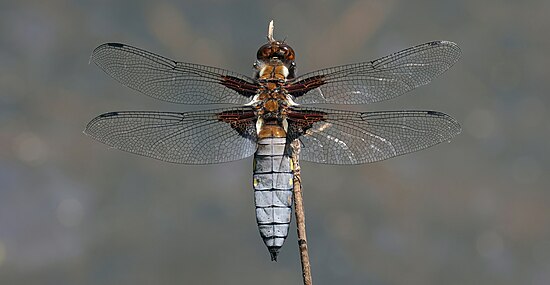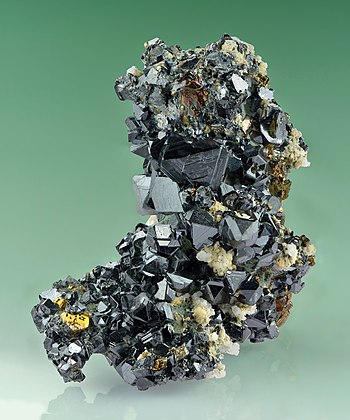|
Featured picture tools: |
These featured pictures, as scheduled below, appeared as the picture of the day (POTD) on the English Wikipedia's Main Page in April 2024. Individual sections for each day on this page can be linked to with the day number as the anchor name (e.g. [[Wikipedia:Picture of the day/April 2024#1]] for April 1).
You can add an automatically updating POTD template to your user page using {{Pic of the day}} (version with blurb) or {{POTD}} (version without blurb). For instructions on how to make custom POTD layouts, see Wikipedia:Picture of the day.Purge server cache
April 1

|
Nelly Martyl (1 April 1884 – 9 November 1953) was a French opera singer based in Paris who participated in several world premieres. After making her professional debut in 1907 in Gluck's Armide, she joined the Opéra-Comique, where she appeared as Micaela in Bizet's Carmen, Sophie in Massenet's Werther, Mimi in Puccini's La bohème and in the title role of Massenet's Manon, among others. During World War I and the 1918 flu epidemic, she worked as a nurse and received the Croix de Guerre for her service. After the war, she created a charitable medical foundation with automobile racer Magdeleine Goüin. This photograph of Martyl was taken by the French photographer Jean Reutlinger, probably between 1907 and 1912. Photograph credit: Jean Reutlinger; restored by Adam Cuerden
Recently featured:
|
April 2

|
|
The European bee-eater (Merops apiaster) is a bird in the bee-eater family, Meropidae. It breeds in southern and central Europe, northern and southern Africa, and western Asia. Except for the resident southern African population, the species is strongly migratory, wintering in tropical Africa. This species, like other bee-eaters, is a richly coloured, slender bird. It has brown and yellow upper parts, whilst the wings are green and the beak is black. It can reach a length of 27–29 cm (10.6–11.4 in), including the two elongated central tail feathers. The most important prey item in its diet is Hymenoptera, mostly the European honey bee. Its impact on bee populations, however, is small. It eats less than 1% of the worker bees in areas where it lives. This group of three European bee-eaters, each with a dragonfly in its mouth, was photographed in Kondor Tanya, Kecskemét, Hungary. Photograph credit: Charles J. Sharp
Recently featured:
|
April 3
|
Sojourner is a robotic Mars rover that landed in Ares Vallis, a channel in the Chryse Planitia region, on July 4, 1997. Sojourner was operational on Mars for 92 sols (95 Earth days). It was the first wheeled vehicle to rove on a planet other than Earth and formed part of the Mars Pathfinder mission. This panoramic photograph is formed of various images of Sojourner taken by the Mars Pathfinder lander, composited into a 360-degree image referred to by NASA as the "presidential" panorama. Since the camera's position was consistent, it is possible to see these images of the rover in the context of the entire landscape.
Recently featured:
|
April 4

|
Al-Wakwak is an island, or possibly more than one island, in medieval Arabic geographical and imaginative literature. Sources variously identify al-Wakwak as representing Japan, Madagascar, Sumatra or Java, with others describing it as an island in the China Sea ruled by a queen with an entirely female population. This painting in watercolor and gold on paper was created in Mughal India in the early 1600s, and depicts a plant that brings forth animal life in multiple forms, derived from a conflation of medieval Persian and Quranic sources, including descriptions of al-Wakwak as inhabited by half-plant and half-animal creatures. The work is now in the collection of the Cleveland Museum of Art in Ohio. Painting credit: unknown
Recently featured:
|
April 5

|
Oligodon, commonly known as the kukri snakes, form a genus of colubrid snakes that was first described by Austrian zoologist Leopold Fitzinger in 1826. This genus is widespread throughout central and tropical Asia. This photograph shows a Hua Hin kukri snake (Oligodon huahin), in Kaeng Krachan National Park, Thailand. Photograph credit: Rushen
Recently featured:
|
April 6

|
|
The Battle of Shiloh, also known as the Battle of Pittsburg Landing, was a major battle in the American Civil War fought on April 6–7, 1862. The fighting took place in southwestern Tennessee, which was part of the war's western theater. Two Union armies combined to defeat the Confederate Army of Mississippi. Major General Ulysses S. Grant was the Union commander, while General Albert Sidney Johnston was the Confederate commander until his battlefield death, when he was replaced by his second-in-command, General P. G. T. Beauregard. Though victorious, the Union army had more casualties than the Confederates, and with an overall total of almost 24,000 injuries and fatalities, it was one of the bloodiest battles in the entire war. This chromolithograph of the Battle of Shiloh was produced by American illustrator Thure de Thulstrup and printed by L. Prang & Co. in Boston in 1888. Illustration credit: Thure de Thulstrup; restored by Adam Cuerden |
April 7

|
The bell miner (Manorina melanophrys), also known as the bellbird, is a colonial honeyeater species endemic to southeastern Australia. The name miner is derived from an old alternative spelling of myna, and is shared with other members of the genus Manorina. The birds feed almost exclusively on the dome-like coverings, referred to as "bell lerps", of certain psyllid bugs that feed on eucalyptus sap from the leaves. The psyllids make these bell lerps from their own honeydew secretions in order to protect themselves from predators and the environment. This bell miner was photographed on the Nepean River in Penrith, New South Wales. Photograph credit: John Harrison
Recently featured:
|
April 8

|
Nithya Menen (born 8 April 1988) is an Indian actress and singer who works primarily in Malayalam, Tamil and Telugu films. After appearing in roles in 1998 and 2006 as a child actress, her first lead role was in the Malayalam film Aakasha Gopuram, which was released in 2008. Her debut in leading roles in Telugu and Tamil films were Ala Modalaindi (2011) and Nootrenbadhu (2011). Her Hindi debut was Mission Mangal (2019). As of 2024, Menen has appeared in more than 50 films and has appeared in several lists of top actresses compiled by Rediff.com and Forbes India. This portrait photograph of Menen was taken in 2023. Photograph credit: Augustus Binu
Recently featured:
|
April 9

|
|
The Andasol solar power station is a 150-megawatt concentrated solar power station and Europe's first commercial plant to use parabolic troughs. Located near Guadix in Andalusia, Spain, the Andasol plant uses tanks of molten salt as thermal energy storage to continue generating electricity, irrespective of whether the sun is shining or not. It consists of three projects, completed in 2008, 2009 and 2011, and occupying a total area of about 200 hectares (490 acres). Because of its high altitude (1,100 m; 3,600 ft) and the semi-arid climate, the site has exceptionally high annual direct insolation. This aerial view of the Andasol plant was taken in 2021, with the snow-capped peaks of the Sierra Nevada in the background. Photograph credit: kallerna
Recently featured:
|
April 10

|
The gatekeeper (Pyronia tithonus) is a species of butterfly in the family Nymphalidae, found across Europe. It is typically orange with two large brown spots on its wings and a brown pattern on the edge of its wings, although a large number of aberrant forms are known. The eyespots on the forewings most likely reduce bird attacks, so it is often seen resting with its wings open. Colonies vary in size depending on the available habitat, and can range from a few dozen to several thousand butterflies. This gatekeeper was photographed in Botley in Oxfordshire, England. Photograph credit: Charles J. Sharp
Recently featured:
|
April 11

|
The Maison carrée (French for 'square house') is an ancient Roman temple in Nîmes, southern France. It is a mid-sized Augustan provincial temple of the imperial cult, and one of the best-preserved Roman temples to survive in the territory of the former Roman Empire. Built in the early 1st century AD, it was dedicated or rededicated to Gaius and Lucius Caesar, grandsons and adopted heirs of Augustus, who both died young. The Maison carrée is similar to a Tuscan-style Roman temple as described in the writings of Vitruvius, a contemporary Roman writer on architecture. It has undergone several restorations over the centuries and was inscribed on the UNESCO list of World Heritage Sites in 2023. This photograph of the Maison carrée at evening was taken in 2019. Photograph credit: Krzysztof Golik
Recently featured:
|
April 12

|
|
The orange chat (Epthianura aurifrons) is a species of bird in the honeyeater family, Meliphagidae, endemic to Australia. With a length of around 10 to 12 centimetres (3.9 to 4.7 inches) and average wingspan of 19 centimetres (7.5 inches), it is a small ground songbird with relatively long, broad and rounded wings and a short square-ended tail. The male's feathers are mostly a deep, warm, cadmium yellow with orange overtones, and this colour is strongest on the crown and breast. Females are mottled in grey-brown, with underparts a softer fawny yellow. Its diet consists mainly of small insects, spiders and other invertebrates that are on the ground or shrubs. Its call consists of a metallic twang tang and a softer tchek tchek sound. This orange chat perched on a twig was photographed near Lake Cargelligo in New South Wales, Australia. Photograph credit: John Harrison
Recently featured:
|
April 13

|
Galena, also called lead glance, is the natural mineral form of lead(II) sulfide (PbS). In addition to lead, some deposits contain up to 0.5 percent silver, in the form of silver sulfide or as limited silver in solid solution; when present, this byproduct far surpasses the main lead ore in revenue. Galena has been used since antiquity, one of its oldest uses being the production of kohl, an eye cosmetic now regarded as toxic due to the risk of lead poisoning. In modern times, galena is primarily used to extract its constituent minerals. In addition to silver, it is the most important global source of lead, for uses such as in lead-acid batteries. This sample of galena, measuring 3.5 cm × 2.5 cm × 2.0 cm (1.38 in × 0.98 in × 0.79 in), contains a small amount of gold-colored pyrite and was extracted from the Huanzala Mine in the Peruvian region of Ancash. This photograph was focus-stacked from 156 separate images. Photograph credit: Ivar Leidus
Recently featured:
|
April 14

|
Nassarius arcularia, commonly known as the casket nassa or the little box dog whelk, is a species of sea snail in the Nassa mud snail or dog whelk family, Nassariidae. It is found in tropical and subtropical coastal waters across the world, inhabiting muddy areas close to the shoreline. The shell, which is very common, has a thickness of up to 3 centimetres (1.2 inches) and varies in form – for example, in the elongation of the whorls and the longitudinal folds – as well as in color, with some specimens entirely white while others have brown bands. The young of this species have folds and striae that are much more prominent. This composite photograph shows five different views of a N. arcularia shell, with a length of 2.2 centimetres (0.87 inches), that was collected in Madagascar. Photograph credit: H. Zell
Recently featured:
|
April 15

|
The Notre-Dame fire was a structural fire that broke out in the roof space of Notre-Dame de Paris, a medieval Catholic cathedral in Paris, France, on 15 April 2019. By the time the fire was extinguished, the cathedral's wooden spire (flèche) had collapsed, most of the wooden roof had been destroyed, and the cathedral's upper walls were severely damaged. Extensive damage to the interior was prevented by the vaulted stone ceiling, which largely contained the burning roof as it collapsed. Many works of art and religious relics were moved to safety, but others suffered smoke damage, and some of the exterior art was damaged or destroyed. The cathedral's altar, two pipe organs, and three 13th-century rose windows suffered little or no damage. Three emergency workers were injured, and the site and nearby areas of Paris were contaminated with toxic dust and lead. Investigators in 2020 believed the fire to have been "started by either a cigarette or a short circuit in the electrical system". French president Emmanuel Macron set a five-year deadline to restore the cathedral. This photograph shows the central section of Notre-Dame's spire engulfed in flames. Photograph credit: Guillaume Levrier
Recently featured:
|
April 16

|
|
Jean Ignace Isidore Gérard (1803–1847) was a French illustrator and caricaturist who published under the pseudonym of Jean-Jacques Grandville or J. J. Grandville. He has been called "the first star of French caricature's great age", and Grandville's book illustrations described as featuring "elements of the symbolic, dreamlike, and incongruous, and they retain a sense of social commentary". The anthropomorphic vegetables and zoomorphic figures that populated his cartoons anticipated and influenced the work of generations of cartoonists and illustrators including John Tenniel, Gustave Doré, Félicien Rops, and Walt Disney. He has also been called a "proto-surrealist" and was greatly admired by André Breton and others in the Surrealist movement. This illustration by Grandville is plate 52 from a 1854 collection of hand-coloured lithographs titled Les métamorphoses du jour (The Metamorphoses of the Day), and depicts five anthropomorphic male dogs following a female dog, all dressed in human clothing. The print is captioned "Temps de canicule", meaning 'heatwave weather' but incorporating a pun in French; canicule literally translates to 'dog days of summer' and may also refer here to animals being 'in heat'. Illustration credit: Jean Ignace Isidore Gérard; restored by Adam Cuerden
Recently featured:
|
April 17

|
The American white pelican (Pelecanus erythrorhynchos) is a large aquatic soaring bird from the order Pelecaniformes. It breeds in interior North America, moving south and to the coasts, as far as Costa Rica, in winter. Along with the trumpeter swan, it is one of the longest birds native to North America, with an overall length of about 50 to 70 inches (130 to 180 cm). The beak measures 11.3 to 15.2 inches (290 to 390 mm) in males and 10.3 to 14.2 inches (260 to 360 mm) in females, while its wingspan is around 95 to 120 inches (240 to 300 cm). The American white pelican does not dive for its food as some other pelican species do, instead catching its prey while swimming. Each bird eats more than 4 pounds (1.8 kg) of food a day, predominantly fish, which ranges from the size of minnows to 3.5-pound (1.6 kg) pickerels. This adult American white pelican in non-breeding plumage was photographed at Las Gallinas Wildlife Ponds in San Rafael, California. Photograph credit: Frank Schulenburg
Recently featured:
|
April 18
|
A basso porto (At the Lower Harbour) is an opera in three acts by the Italian composer Niccola Spinelli. The opera sets an Italian-language libretto by Eugene Checchi, based on Goffredo Cognetti's 1889 play O voto. It premiered to critical success at the Cologne Opera on April 18, 1894, sung in a German translation by Ludwig Hartmann and Otto Hess. This watercolour illustration depicts the set design by Riccardo Salvadori for act 1 of the opera's premiere. A basso porto is set in the slums of Naples, and Spinelli included mandolins and guitars in his orchestral score. Set design credit: Riccardo Salvadori
Recently featured:
|
April 19

|
Picea omorika, commonly known as the Pančić spruce or the Serbian spruce, is a species of coniferous tree endemic to the valley of the Drina in western Serbia, and eastern Bosnia and Herzegovina, with a total range of only about 60 hectares (150 acres) at altitudes of 800 to 1,600 metres (2,625 to 5,249 ft). The species was originally discovered near the Serbian village of Zaovine on Mount Tara in 1875, and named by the Serbian botanist Josif Pančić. It is a medium-sized evergreen tree that generally grows to a height of around 20 metres (66 ft), with a trunk diameter of up to 1 metre (3 ft). It has buff-brown shoots with dense hair coverage and needle-like leaves. Its cones are fusiform in shape and grow to a length of 4 to 7 centimetres (2 to 3 in). They are dark purple when young, maturing to dark brown, and have stiff scales. This young female P. omorika cone, with a length of 22 millimetres (0.87 in), was photographed near Keila, Estonia. Photograph credit: Ivar Leidus
Recently featured:
|
April 20

|
|
Tarazona is a town and municipality, and the capital of the comarca Tarazona y el Moncayo in Aragon, Spain. It is also the seat of the Roman Catholic Diocese of Tarazona. Located on the river Queiles, a tributary of the Ebro, Tarazona was an important regional centre of ancient Rome, known as Turiaso, located around 60 kilometres (37 miles) from Bilbilis. The city later came under the rule of the Visigoths, who called it Tirasona. This view of Tarazona was taken from the city's episcopal palace, and shows Tarazona Cathedral and its seminary, the Old Bullfight Arena, and the Sanctuary of the Lady of the River. Photograph credit: Diego Delso
Recently featured:
|
April 21

|
Walter White (1893–1955) was an American civil rights activist who led the National Association for the Advancement of Colored People (NAACP) for a quarter of a century, from 1929 until his death. He directed a broad program of legal challenges to racial segregation and disfranchisement. Under his leadership, the NAACP oversaw the plans and organizational structure of the fight against public segregation in the United States. He worked with President Harry S. Truman on desegregating the armed forces after World War II and gave him a draft of Executive Order 9981 to implement this. Under White's leadership, the NAACP set up its Legal Defense Fund, which conducted numerous legal challenges to segregation and disfranchisement, and achieved many successes. This photograph of White was taken by Clara Sipprell around 1950, and is in the collection of the National Portrait Gallery in Washington, D.C. Photograph credit: Clara Sipprell; restored by Adam Cuerden
Recently featured:
|
April 22

|
Pelophylax cypriensis, commonly known as the Cyprus water frog, is a species of frog in the family Ranidae, the true frogs. It is endemic to Cyprus. It is a medium-sized frog, with females (body length up to 75 mm, 3.0 in) being larger than males (up to 65 mm, 2.6 in). The skin is rather warty and colouration varies widely. There are four unwebbed toes on the front legs and five webbed toes on the hindlegs. Males have paired external vocal sacs. This Cyprus water frog was photographed under the Elia Bridge in Limassol District, Cyprus. Photograph credit: Charles J. Sharp
Recently featured:
|
April 23

|
Bistorta officinalis, also known as he common bistort, is a species of flowering plant in the dock family Polygonaceae. It is native to Europe and northern and western Asia, but has also been cultivated and become naturalized in other parts of the world such as in the United States. It is typically found growing in moist meadows, nutrient-rich wooded swamps, forest edges, wetlands, parks, gardens and disturbed ground. A herbaceous perennial, it grows to a height of 20 to 80 centimetres (8 to 31 inches). It blooms from late spring into autumn, producing tall, erect, unbranched and hairless stems ending in single terminal racemes that are club-like spikes, 5 to 7 centimetres (2 to 3 inches) long, of rose-pink flowers. This B. officinalis inflorescence was photographed in the Austrian Alps. Photograph credit: Uoaei1
Recently featured:
|
April 24

|
Luis Walter Alvarez (1911–1988) was an American experimental physicist who was awarded the Nobel Prize in Physics in 1968 for his discovery of resonance states in particle physics using the hydrogen bubble chamber. After receiving his PhD from the University of Chicago in 1936, Alvarez went to work for Ernest Lawrence at the Radiation Laboratory at the University of California, Berkeley. He joined MIT Radiation Laboratory in 1940, where he contributed to a number of World War II radar projects and worked as a test pilot, before joining Robert Oppenheimer on the Manhattan Project in 1943. He moved back to Berkeley as a full professor after the war, going on to use his knowledge in work on improving particle accelerators. This 1969 photograph shows Alvarez with a magnetic monopole detector at Berkeley. Photograph credit: Lawrence Berkeley National Laboratory / Department of Energy
Recently featured:
|
April 25

|
The Madagascar stonechat (Saxicola sibilla) is a species of stonechat endemic to Madagascar. It is a small bird, closely similar to the African stonechat in both plumage and behaviour, but distinguished from it by the more extensive black on the throat and minimal orange-red on the upper breast of the males. This male Madagascar stonechat perching on a branch was photographed in Analamazaotra National Park, near Andasibe. Photograph credit: Charles J. Sharp
Recently featured:
|
April 26

|
|
Lichfield Cathedral is a Church of England cathedral in Lichfield, in the English county of Staffordshire. A cathedral was first built on the site in 700, by Bishop Headda, to house the bones of St Chad. The original wooden building was replaced by a Norman cathedral made from stone, which in turn was replaced by the present Gothic structure, begun in 1195. The fabric of the cathedral suffered in the English Civil War, when it was used as a defensive structure. In the 18th century the interior was extensively remodelled, with major structural work organised by James Wyatt; this involved removing the high altar to make a single worship area consisting of the choir and lady chapel, and adding a massive stone screen at the entrance to the choir. This photograph shows the choir of the cathedral, which was built around 1200. Photograph credit: David Iliff
Recently featured:
|
April 27

|
Benjamin Franklin Tilley (1848–1907) was a career officer in the United States Navy who served from the end of the American Civil War through the Spanish–American War. He is best remembered as the first acting governor of American Samoa as well as the territory's first naval governor. Photograph credit: unknown photographer; Naval History and Heritage Command; restored by Adam Cuerden
Recently featured:
|
April 28

|
|
Libellula depressa, commonly known as the broad-bodied chaser or broad-bodied darter, is a dragonfly in the family Libellulidae. One of the most common dragonflies in Europe and central Asia, its range extends to England, central Asia and the Middle East, with a few limited populations in Scotland. It is not found in Ireland or North Africa, however. This insect is around 39 to 48 millimetres (1.5 to 1.9 inches) in length, with both the male and the female having a broad, flattened abdomen which is brown with yellow patches down the sides. In the male, the abdomen develops a blue pruinescence that covers the brown colour. Both fore and hind wings have a dark patch at the base. This male L. depressa dragonfly was photographed at Wolvercote Lakes in Oxfordshire, England. Photograph credit: Charles J. Sharp
Recently featured:
|
April 29

|
Sphalerite is a sulfide mineral with the chemical formula (Zn,Fe)S. It is found in a variety of deposit types, and is found in association with galena, chalcopyrite, pyrite (and other sulfides), calcite, dolomite, quartz, rhodochrosite, and fluorite. Sphalerite is an important ore of zinc, with around 95 percent of all primary zinc extracted from its ore. Due to its variable trace-element content, sphalerite is also an important source of several other metals such as cadmium, gallium, germanium and indium. The zinc in sphalerite is also used to produce brass. This sample was extracted in Creede, Colorado, and features black tetrahedral crystals of sphalerite up to 8 mm (0.31 in) in size, with minor chalcopyrite and calcite, in a 4.5 cm × 3.0 cm × 2.0 cm (1.77 in × 1.18 in × 0.79 in) matrix. This photograph was focus-stacked from 125 separate images. Photograph credit: Ivar Leidus
Recently featured:
|
April 30

|
Pelléas et Mélisande is an opera in five acts with music by the French composer Claude Debussy. The French-language libretto was adapted from Maurice Maeterlinck's symbolist play Pelléas and Mélisande. The plot concerns a love triangle between Prince Golaud, Mélisande (a mysterious young woman he had found lost in a forest), and Golaud's younger half-brother Pelléas. The only opera Debussy ever completed, Pelléas et Mélisande premiered on 30 April 1902 at the Salle Favart in Paris, performed by the Opéra-Comique, with Jean Périer as Pelléas and Mary Garden as Mélisande. The premiere was conducted by André Messager, who was instrumental in getting the Opéra-Comique to stage the work. This poster by the French painter Georges Rochegrosse was produced for the premiere. Poster credit: Georges Rochegrosse; restored by Adam Cuerden
Recently featured:
|
Picture of the day archives and future dates
